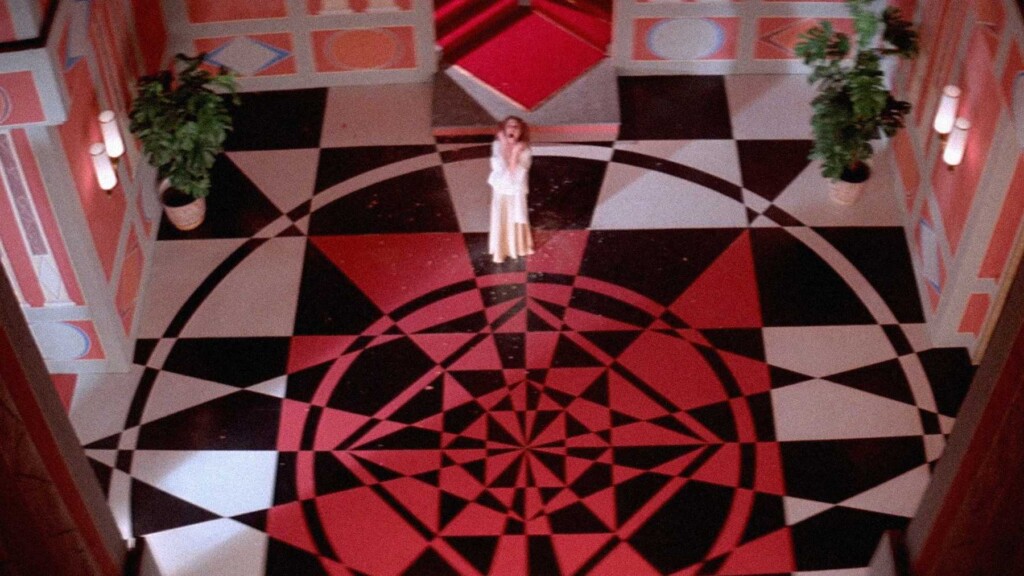“Hell is behind that door!”
A few years back, when reviewing the wretched, incompetent Friday the 13th, I wondered if a movie can be considered a classic if it isn’t any good. Suspiria made me ask the same question (but to be clear, this movie is far, far better than Friday, which is irredeemable). The acting is wooden, the plotting uninspired, the dubbing atrocious…but in spite of all that – or maybe because of it – Suspiria is unforgettable. Parts of it might not hold up today, but there’s no denying this is a classic.
The first thing you see are the colors: lurid pastels, intrusive primary colors that turn the world of Dario Argento’s film into a kaleidoscope. As Suzy Banion (Jessica Harper) makes her way by cab through the streets of Germany, it’s as though she’s passing out of her reality and into a new one. Suspiria unfolds not like a dream or a nightmare, but like a hallucination. No matter what relationship each scene is supposed to have to the last, it feels episodic, like a series of vignettes. This is aided by Harper’s performance (which, to be fair, is uneven at best); she seems to take everything in stride, whether it’s being refused entrance to the dance academy on her first night in Germany, or seeing a fellow student escaping and running for her life through the woods. Suzy is a cipher, but that’s her role.

We see that runaway student (named Pat Hingle, and played by Eva Axen) taking refuge at a friend’s apartment, and soon falling prey to a killer’s knife. Suspiria isn’t scary in the traditional sense, but my God is it beautiful to look at, even and especially in its more graphic moments, such as an already-dead Pat falling through a glass ceiling with a noose around her neck. Argento uses color in a way that is quite frankly astonishing; for a modern example, one would have to look at Moonlight or Speed Racer or Mishima: A Life in Four Chapters.
The plot unfolds pretty how much you would imagine. Argento would have been better served by giving his film some more breathing room; there’s a reason that Luca Guadagnino turned his 2018 remake of Suspiria into a 150-minute movie (more on that tomorrow). Things feel rushed and under-developed. This is not helped at all by the terrible performances – but the score (by Argento and prog band Goblin) is so incredible, so counterintuitive and eerie, that one starts to think that Suspiria would work best as a silent film. The best things about it, after all, are the music and the visuals, the latter of which are unparalleled in horror. Suspiria‘s influence is indelible and far-ranging.
But you have to look at a movie as more than a collection of images (something like Koyaanisqatsi notwithstanding, I suppose). It’s hard to look past the wooden acting and overwrought delivery of every line. The dubbing doesn’t help; it makes sense when you realize that only occasionally did actors in the same scene speak the same language. Sometimes they didn’t speak at all, knowing that their lines would be dubbed in after the fact. (Harper mused that it was strange to act out a scene while listening to the sawing and hammering of stagehands elsewhere in the sound stage.)

What do we want out of a film like Suspiria? It would be nice to be scared, and it’s not like that’s an impossibility; we’ve covered older films than this here, and movies like Rosemary’s Baby and The Exorcist have lost none of their ability to frighten. Argento is renowned as a horror director, and Suspiria is his most well-known achievement (with the possible exception of The Bird With the Crystal Plumage and Cat O’Nine Tails). I don’t think he was looking for horror here – which is why, despite all its technical shortcomings, Suspiria remains effective. It’s visual storytelling at its most sumptuous, with a use of color that signals nothing less than an entry into a world completely alien to our own, something older and stranger, with rules that we’re not meant to know.
I’m thinking of the line I quoted at the top of this review. It comes at the film’s climax, but could easily come at the beginning. We watch Suzy, in the middle of a downpour, begging for entry into the dance academy. She’s left everything behind in America, her life reduced to two suitcases. This is all she has. She pulls at the door. Hell is behind that door.
Thursday, 10/1: Phantasm
Friday, 10/2: Frozen
Saturday, 10/3: Suspiria
Sunday, 10/4: Suspiria (2018)
Monday, 10/5: Emelie
Tuesday, 10/6: Castle Freak
Wednesday, 10/7: Session 9
Thursday, 10/8: The Texas Chainsaw Massacre 2
Friday, 10/9: We Are Still Here
Saturday, 10/10: The Changeling
Sunday, 10/11: The Bad Seed
Monday, 10/12: Verotika
Tuesday, 10/13: The Legend of Hell House
Wednesday, 10/14: Lake Mungo
Thursday, 10/15: Puppetmaster
Friday, 10/16: Marrowbone
Saturday, 10/17: A Nightmare on Elm Street 4: The Dream Master
Sunday, 10/18: Halloween 4: The Return of Michael Myers
Monday, 10/19: Sweetheart
Tuesday, 10/20: Girl On the Third Floor
Wednesday, 10/21: Behind the Mask: The Rise of Leslie Vernon
Thursday, 10/22: Triangle
Friday, 10/23: Dog Soldiers
Saturday, 10/24: Noroi: The Curse
Sunday, 10/25: Train to Busan
Monday, 10/26: Tales From the Hood
Tuesday, 10/27: Mandy
Wednesday, 10/28: Sometimes They Come Back
Thursday, 10/29: Veronica
Friday, 10/30: The Wicker Man
Saturday, 10/31: Child’s Play

